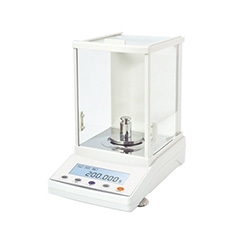Digital analytical balances find applications in various scientific disciplines, including chemistry, biology, pharmacy, and material science. They are crucial for tasks that require precise measurement of small quantities, such as preparing solutions, determining the mass of reagents, or conducting analytical experiments.
The key feature of an electronic analytical balance is its ability to provide measurements with a high level of sensitivity and accuracy, often up to several decimal places. These balances are equipped with digital readouts that display the weight of the sample being measured. The digital display allows for easy and quick reading of measurements, reducing the likelihood of human error associated with manual readings.
The functioning of an analytical weighing scale involves a load cell or strain gauge system, which detects the force exerted by the sample being weighed. This force is then converted into an electrical signal and processed by a microprocessor, resulting in a digital readout on the display. The balances are often designed to minimize external influences such as air currents and vibrations, ensuring the accuracy of the measurements. In the following, we will show you our analytical weighing balance price.
Digital Analytical Balance Price List:
| Product | SKU | Capacity | Stable Time | Price |
 |
SISCO-DAB-200 | 200g | ≤3s | $790.52 |
| SISCO-DAB-300 | 300g | $801.32 | ||
| SISCO-DAB-500 | 500g | $841.57 | ||
| SISCO-DAB-600 | 600g | $870.15 | ||
| SISCO-DAB-1000 | 1000g | $1,136.21 | ||
| SISCO-DAB-1200 | 1200g | $1,219.56 |
How to Use Analytical Weighing Balance?
- Setup. Place the balance on a stable and vibration-free surface. Ensure that the balance is level; use the built-in leveling feet if necessary. Keep the balance away from drafts and air currents.
- Power On. Turn on the balance using the power button.
- Calibration. Check if the balance requires calibration. Some balances may need regular calibration to maintain accuracy. Follow the manufacturer's instructions for calibration. This often involves using standard calibration weights.
- Press "Zero" Button. Before placing any sample on the balance, press the "Tare" or "Zero" button. This sets the balance to zero, subtracting the weight of the container.
- Sample Placement. Open the draft shield if your balance has one. Carefully place the sample or substance to be weighed onto the center of the balance pan.
- Record Reading. Allow the lab weighing balance to stabilize before recording the weight. The display will show a stable reading once equilibrium is reached.
- Cleanliness. Keep the analytical balance clean. Use lint-free wipes and a mild cleaning solution for any spills. Avoid contact with corrosive substances.
- Handling Weights. Use clean, dry, and non-magnetic tweezers or forceps to handle weights or samples. This helps to avoid contamination and maintains accuracy.
- Closing the Draft Shield. If you used the draft shield, close it after weighing to prevent air currents from affecting the measurement.
- Power Off. Turn off the balance when finished to conserve power.
- Maintenance. Follow any specific maintenance guidelines provided by the manufacturer. This may include regular cleaning and performance checks.
- Safety Precautions. Adhere to any safety guidelines provided in the user manual. Avoid overloading the balance and be cautious with hazardous materials.
The digital aspect of these lab balances makes them more user-friendly and often enhances the overall efficiency of weighing processes. In sisco online shop, you will find a satisfactory analytical balance. As technology continues to evolve, digital analytical balances are likely to see further improvements, contributing to the advancement of scientific knowledge and the quality of products in diverse fields.

